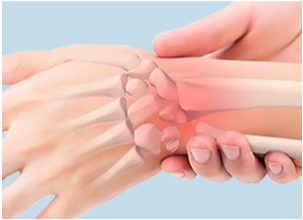Introduction
Wrist sprains are injuries that are common in sports but can also happen during activities of daily living. A wrist sprain is a result of a high force acting on the palm of the hand such as in a fall. We tend to automatically stick our hands out to break or soften the fall. However, a big fall can put too much pressure on wrists resulting in stretching out of the ligaments. In rare occasions, a wrist sprain can also happen from the wrist being hit or twisted.
Depending how bad the ligaments are stretched, a wrist sprain can be classified as a grade 1, 2 or 3, with 1 being the mildest and 3 being the most severe type.

Grade 1:
- Mild pain with minor damage to the ligament, which can take 1 to 3 weeks for recovery.
Grade 2:
- Pain is more severe along with more serious damage to the ligaments. Wrist will feel much limited in strength, range of motion, and function, and usually takes 3 to 6 weeks for recovery.
Grade 3:
- Severe pain due to complete tear of one or multiple ligaments. This type of sprain will result in loss of function and usually requires surgery and at least several months for recovery.
Symptoms
A wrist sprain is typically experienced with pain along with loss of function, swelling, bruising, stiffness, weakness, and popping or tearing inside the wrist.

Who is more prone to wrist sprains?
Wrist sprains can happen in many sports. These can include basketball, baseball, gymnastics, diving, skiing, snowboarding, skateboarding, and inline skating. No matter what sport or movement it is, any action resulting in falling onto the hands can result in a wrist sprain.
How is a wrist sprain treated?
Wrist sprain recovery can be classified in both passive and active recovery.
Passive recovery follows the P.R.I.C.E. principle – protect, rest, ice, compress, and elevate. Physiotherapy can also fall under passive recovery as manipulation, ultrasound, and needling all work to accelerate healing.
Active recovery can occur under the supervision of a physiotherapist or kinesiologist. It consists of exercises with the goal of regaining and strengthening function of the wrist.
A follow-up blog post will be added with more information on active recovery. You can also call us to book an assessment with a physiotherapist if you are suffering from a wrist sprain, and they will inform and aid you with both passive and active recovery. It is possible for you to work with one of our on-site kinesiologists after your assessment at no additional charge.
Nichita Kukuskin
Registered Kinesiologist

Recent Comments